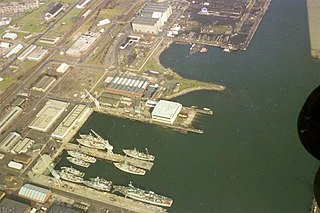
The Far East Fleet was a fleet of the Royal Navy which existed between 1952 and 1971.

The Home Fleet was a fleet of the Royal Navy that operated from the United Kingdom's territorial waters from 1902 with intervals until 1967.

The Commander-in-Chief Fleet (CINCFLEET) was the admiral responsible for the operations of the ships, submarines and aircraft of the British Royal Navy from 1971 until April 2012. The post was subordinate to the First Sea Lord, the professional head of the Naval Service. In its last years, as the Navy shrank, more administrative responsibilities were added.

Rosyth Dockyard is a large naval dockyard on the Firth of Forth at Rosyth, Fife, Scotland, owned by Babcock Marine, which formerly undertook refitting of Royal Navy surface vessels and submarines. Before its privatisation in the 1990s it was formerly the Royal Naval Dockyard Rosyth. Its primary role now is the dismantling of decommissioned nuclear submarines. It is also the integration site for the Royal Navy's newest aircraft carriers, the Queen Elizabeth class as well as the Type 31 Frigate.

The Atlantic Fleet was a naval fleet of the Royal Navy. It existed for two separate periods; 1909 until 1914, and then 1919 until 1932.

Fleet Operational Sea Training (FOST) is a Royal Navy training organisation.

The Eastern Fleet, later called the East Indies Fleet, was a fleet of the Royal Navy which existed between 1941 and 1952.

The Admiral-superintendent, Portsmouth was the Royal Navy officer in command of the Naval Dockyard. Portsmouth from 1832 to 1971; prior to this date a resident Commissioner of the Navy Board had had oversight of the yard, since 1649. In may 1971 command responsibility for naval staff in the dockyard was merged into the wider local command structure, initially under the dual designation of Flag Officer, Portsmouth and Admiral Superintendent, Portsmouth but in July 1971 was again renamed Flag Officer Spithead and Port Admiral Portsmouth after a couple of months. These joint titles was used until 1975, and despite the name change the command still covered the same geographic area and operational responsibilities until 1996 when its ceased to exist as a separate command appointment and its responsibilities were assumed by the staff of Flag Officer First Flotilla.

The Royal Navy 5th Destroyer Squadron was a naval unit of the Royal Navy (RN) from 1952 to 2002.

The Assistant Chief of Naval Staff formerly the Assistant Chief of the Naval Staff is a senior Royal Navy appointment responsible for naval aviation. The post is also the successor to the Royal Navy's Flag Officer for naval aviation in the British Isles, established since 1939.
Rear Admiral James Campsie Rapp CB is a former Royal Navy officer who served as Flag Officer Sea Training.
Rear Admiral John Oliver Roberts is a former Royal Navy officer who served as Flag Officer, Naval Air Command.

The Training and Staff Duties Division and later known as the Tactical and Staff Duties Division was a directorate of the Admiralty Naval Staff of the Royal Navy responsible for the tactical use of naval weapons and the training of naval personnel in relation to operational requirements from 1917 to 1958.

The Naval Recruitment Training Agency (NRTA) originally called the Naval Training Department was first established in 1944 as a department within the Admiralty it underwent numerous name changes until 1 April 1995 as a new agency of the Navy Department of the British Ministry of Defence. Its role was to contribute to the operational capability of the United Kingdom Armed Forces by recruiting to the Naval Service, delivering training to the Defence community it was administered by the Chief Executive (NRTA)/Flag Officer, Training and Recruitment it was abolished in 2005.
The First Flotilla was a naval formation of the British Royal Navy commanded by the Flag Officer, First Flotilla from 1971 to 1990.

The Flag Officer, Flying Training, later called Flag Officer Naval Flying Training, was a senior Royal Navy appointment responsible for all naval aviation flying training from 1945 to 1970.

The Rear-Admiral, Reserve Aircraft also known as Rear-Admiral, (E) Reserve Aircraft was a senior Royal Navy appointment responsible for all administering all Naval Air Stations Reserve Aircraft, Aircraft Repair Yards and trials of Aircraft Carriers from 1949 to 1956.

The Flag Officer, Air and Second-in-Command, Mediterranean Fleet was a senior command appointment of the British Royal Navy from January 1947 to 1958 who also administered the 2nd Aircraft Carrier Squadron from 1947-1951. The appointment was a continuation of the Second-in-Command, Mediterranean Station first established in 1861 that underwent a series of name changes due to an expansion of additional duties given to the post holder.

The Directorate of Navigation and Tactical Control (Naval) was a directorate of the Navy Department, Naval Staff first established in 1912 as the Navigation Department of Hydrographic Department of the Admiralty. In 1945 it was renamed the Navigation Division and assigned to the Admiralty Naval Staff. In 1946 it was re designated Navigation and Direction Division until 1966 and now part of the Navy Department Naval Staff it was renamed the Directorate of Navigation and Tactical Control (Naval). The staff directorate was administered by the Director Navigation Tactical Control (Naval) who reported to the Assistant Chief of the Naval Staff (Warfare) it existed until 1968.







